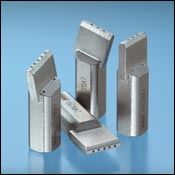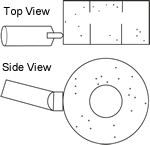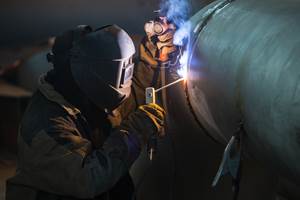Synthetic-Diamond Dressing Tools: Why Not Use Them?
Synthetic-diamond dressing tools are often a superior alternative to natural-diamond dressing tools for conditioning a grinding wheel. The reason is the consistency that the synthetic-diamond tools bring to the process.
What you have heard is true. The more consistent a stationary dressing tool is, the more consistent the grinding. By design, dressing tools with synthetic diamonds can provide a level of wheel consistency few other types of stationary dressing tools offer. While synthetic-diamond dressing tools are not “end-all” products designed to replace natural-diamond tools, they do offer an alternative that takes consistency and productivity in wheel conditioning to a whole new level. Whether you are thinking about trying synthetic-diamond tools or hearing about them for the first time, there are a few things you’ll need to know to use them effectively.
Comparing Synthetics To Natural Tool Stones
Just how do synthetic tool stones differ from natural diamonds?
- Synthetic diamonds are available in a variety of close-tolerance sizes and lengths, whereas natural diamonds tend to mimic one of five basic shapes.
- Synthetics are produced under tightly controlled conditions for consistency to avoid internal imperfections normally associated with natural diamonds.
- Rectangular synthetic stones, often called logs or rods, are longer than most natural elongated stones, giving them a significant life advantage.
- Rectangular synthetic diamonds are consistently shaped their entire length. This ensures consistent wheel conditioning for the entire length of the stone. As noted below, when natural stones wear down, so does their ability to condition the grinding wheel.
What Is It About Synthetics?
It may be difficult to see at first, but over time, dressing-tool diamonds develop wear flats. With natural diamonds, problems begin as wear flats increase in size and eventually become too big. The exact point at which this excessive wear occurs is known as the transition point. Once a wear flat passes the transition point in size, the tool becomes dull and, in turn, it dulls the wheel (that is, closes its porosity) rather than sharpens the wheel (that is, opens its porosity). Synthetic diamonds are consistently shaped so that their wear flats never get larger. This feature gives them a significant advantage because they will never transform sharp wheels into dull ones, as natural stones do.
Improving Productivity
Unlike natural-diamond tools, synthetic-diamond tools never require indexing (rotating) to keep their wear flats from growing too large too fast. So, an operator using a synthetic-diamond tool no longer has to interrupt production to index the tool in order to keep the wear flats from growing too large. Of course, operating without indexing reduces downtime and thereby increases productivity. Additional productivity gains occur because longer synthetic diamonds simply outlast short natural diamonds, thus reducing tool changes and subsequent CNC machine touch-offs.
Synthetic diamond grows shorter with use and not larger in contact area (wear flat diameter) to the wheel. Consequently, synthetic diamonds can be used effectively until they are quite short—shorter than a natural diamond could ever be. Most manual and CNC grinding machines can readily adjust for diamond tools wearing shorter, whereas few have automatic diamond-tool indexers to maintain wear flat sizes.
Synthetic tools can also be marked at the factory with diamond depth lines. This feature allows operators to forecast diamond life and change worn tools at the beginning of large production runs, thereby avoiding unnecessary production interruptions for tool changeovers.
Specifics On synthetics
Synthetic diamonds are rectangular in shape. However, when they are mounted in tools with only the ends visible, they appear square. The square shapes are used to size the stone for use in a tool. Application specifics such as wheel size, wheel shape, machine type and so on are important factors in specifying a diamond size. The diamond selected is typically the largest (square shape) that does not exceed the size of the transition point. See Figure 1.
The Availability Of Synthetic Tools
With some minor physical modifications, most tool types can be made with synthetic diamonds. Synthetic tools are configured a bit differently in certain situations to favor the rectangular shape of the tool stones. The most popular synthetic tools are blade tools with multiple stones. However, as interest in synthetic-diamond tools grows, so does interest in single points, chisels and diaform configurations. Interestingly, synthetic tools can be configured to dress opposing corner radii in a single pass with CNC. That procedure is something natural-diamond tools have trouble performing.
Six Steps To Getting Started
Once you’ve made the decision to try synthetic-diamond dressing tools, these six steps will help you make the transition successfully:
Selecting a synthetic diamond type
There are two popular synthetic diamond types used in dressing tools; monocrystalline and CVD (chemical vapor disposition). Both work well for truing and dressing conventional grinding wheels.
Monocrystalline diamond, as the name implies, is grown from a single (mono) crystal into a large form, and is then cut into specific shapes for use in dressing tools. Monocrystalline diamonds are easily recognized by their uniform appearance and greenish-yellow color. Testing has revealed that in dressing applications, monocrystalline diamonds are the more durable and more expensive of the two synthetics.
CVD diamonds are produced using a special manufacturing process that creates diamond crystals from a chemical vapor. Once formed, this material is cut into smaller sizes for use in dressing tools. CVD diamonds are uniformly shaped and easily recognized by their black color.
Specifying diamond size and shape
The process of selecting natural-diamond tool-stone sizes and shapes for use in dressing tools is based upon important application specifics such as grinding tolerances, grinding wheel size and abrasive type. This same application information is just as important when selecting synthetic diamonds. However, the process used in selecting the diamonds is very different. Both the size (cross-sectional area) and the length of a diamond are important.
Most diamond tool manufacturers offer a range of synthetic diamonds in 0.4 mm-, 0.6 mm-, 0.8 mm- and 1.0 mm-square sizes. The lengths of the square shaped stones range from 3 mm to 5 mm. The most common length is 3 mm.
Deciding how many stones to use
Unlike operations using natural-diamond tools, in which a single stone is often used, an equivalent synthetic tool may use up to five synthetic stones mounted in a blade. The recommended number of stones will vary by application and is derived directly from the application specifics, which include wheel specifications and finish requirements. As a general rule, the larger the wheel size, the larger the number of synthetic stones that are required and the larger those stones will have to be. Either follow the guidelines shown in Table 1 or contact a Saint-Gobain diamond-tool application engineer for assistance.
Table 1--Synthetic Stone Selection Guidelines
Grinding wheel
diameter*
Recommended number
of stones
‹ 11 inches (‹ 279mm)
1
12 – 17 inches (304 – 431mm)
2
18 – 29 inches (457 – 736mm)
3-4
30 – 36 inches (737 -914mm)
5
*For wheel widths › 6 inches, add a stone
Specifying diamond orientation
When using synthetic diamonds, the orientation of the square-shaped stone plays a very important role in tool performance. Misaligned or poorly oriented stones can negatively impact your ability to achieve optimum wheel conditioning. In general, set the diamond(s) angled or diagonal (as shown ). For heavy-duty applications, rotate the diamond(s) 45 degrees () as needed.
Getting the tool configured correctly
Don’t be locked into existing tool designs. Many conversions to synthetic tools require a slightly different tool configuration, which often ends up being a blade tool. These modifications are often necessary because of the differences between natural and synthetic diamonds. For example, multiple stones should be mounted vertically on blade configurations so only one diamond width makes contact as the tool moves across the wheel. It is also important that the shank orient the diamonds so that the stones are aligned perpendicular to the wheel face as shown in the box, “Tech Tips.”
Using synthetic tools correctly
Operate synthetic dressing tools using the same dressing parameters you use for natural-diamond tools. One word of caution: when overheated, synthetic diamonds tend to weaken faster than natural diamonds. Operators using synthetic tools should be disciplined and not exceed the recommended diamond dressing tool speeds and feeds.
Synthetics Are Worth Considering
Whether you’re considering the use of synthetic diamonds to improve wheel-conditioning consistency or to avoid interrupting production to index the diamonds, synthetic dressing tools have much to offer. As mentioned earlier, synthetic dressing tools will not bring an end to the use of natural-diamond tools. However, synthetics are desirable in certain applications and suitable for use in many different tools types.
Getting started is not all that difficult if you follow the steps outlined above.
Related Content
How To Calibrate Your Calipers
If you’re interested in calibrating your own digital, dial or Vernier calipers, here are some steps to take to make sure it goes off without a hitch.
Read MoreUnderstanding The Four Major Behavioral Styles
Companies today are expanding the role of teams in the workplace in an effort to empower employees and improve organizational effectiveness. The more we try to work as a team, the more important it becomes to recognize that people exhibit different behavioral styles.
Read MoreUnderstanding Errors In Hand-Held Measuring Instruments
Different instruments (and different operators) are prone to different errors.
Read MoreSelecting The Right Welder
Many machine shops, on occasion, have a need for welding. It may be for maintenance purposes, repair or to fill the odd contract. This story is a welding process primer for those shops whose main business isn't welding but need to know some basics.
Read MoreRead Next
The Cut Scene: The Finer Details of Large-Format Machining
Small details and features can have an outsized impact on large parts, such as Barbco’s collapsible utility drill head.
Read More3 Mistakes That Cause CNC Programs to Fail
Despite enhancements to manufacturing technology, there are still issues today that can cause programs to fail. These failures can cause lost time, scrapped parts, damaged machines and even injured operators.
Read More















.png;maxWidth=300;quality=90)



.png;maxWidth=300;quality=90)












